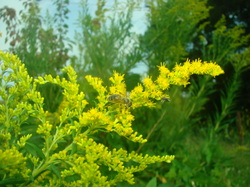
The Big New York State Honey Harvest
By Pat Bono / [email protected]
on September 10, 2013
Shorter days and cooler temperatures herald the traditional honey harvest here in New York State.
Beekeepers are preparing to remove the sweet bounty that the honeybees have collected from the
various flowers that bloom in the state. The sweet and varied flavors of honey differ according to the
type of flower the nectar is gathered from, be it from manged plants like apple blossoms or blueberries,
cultivated garden stock such as honeysuckle, mint, flowering bushes and trees, to the wildflowers of
New York.
The Empire State has some of the best honey in the nation, due to the temperature climate, adequate
rainfall, and the rich limestone soils. The state is geographically diverse, presenting a quiltwork of
fields, meadows, agricultural crops and orchards, swamps, mountains, fallow lands, suburban and
urban gardens – all of which provide bees a variety of nutritious flower nectars and pollens to choose
from.
Generally earlier Spring and Summer honeys tend to be lighter and sweeter, and used as tea honeys.
Later honeys tend to to be darker and more flavorful and are good for baking
Many apiarists are eager to market their Fall honey, one the most abundant and one of the best of the
New York honeys. What makes this honey so special? It is an especially dark rich and robust honey
with an almost butterscotch type flavor. The primary floral source the bees visit to make this honey is
the humble roadside and field weed- Goldenrod (solidago), a native North American species.
This honey can be found at local farm stands, farmers markets, and harvest festivals throughout New
York State. The Empire State State Honey Producers has a listing of beekeepers, many of whom
produce autumn honey, on their website, http://www.eshpa.org/index.php/buy-local-ny-honey/2011-12-
30-19-04-58
September is also National Honey Month, which recognizes the great nationwide honey harvest
across the United States.
New York currently ranks #14 in honey production, with about 2.7 million pounds produced, the
number of managed beehives in NY is 52,000 and increasing.
Honey Chocolate Chip Cookies
Ingredients:
½ C New York honey
½ C butter
1 egg
1/2 tsp. vanilla
1 1/2 C flour
1 1/2 tsp. baking soda
1/4 tsp. baking powder
1/2 tsp. Salt
1 C chocolate chips
½ C ground walnuts (optional)
Cream honey and butter together. Add egg and vanilla. In bowl, mix flour, soda, powder and salt
together. Add flour mix. Add nuts and chocolate chips. Drop onto cookie sheet and bake at 350 for 11-
12 minutes.
-Pat Bono is the Project Director for NY Bee Wellness (NYBeeWellness.org), a USDA funded organization to teach beekeepers how to diagnose honey bee disease.
By Pat Bono / [email protected]
on September 10, 2013
Shorter days and cooler temperatures herald the traditional honey harvest here in New York State.
Beekeepers are preparing to remove the sweet bounty that the honeybees have collected from the
various flowers that bloom in the state. The sweet and varied flavors of honey differ according to the
type of flower the nectar is gathered from, be it from manged plants like apple blossoms or blueberries,
cultivated garden stock such as honeysuckle, mint, flowering bushes and trees, to the wildflowers of
New York.
The Empire State has some of the best honey in the nation, due to the temperature climate, adequate
rainfall, and the rich limestone soils. The state is geographically diverse, presenting a quiltwork of
fields, meadows, agricultural crops and orchards, swamps, mountains, fallow lands, suburban and
urban gardens – all of which provide bees a variety of nutritious flower nectars and pollens to choose
from.
Generally earlier Spring and Summer honeys tend to be lighter and sweeter, and used as tea honeys.
Later honeys tend to to be darker and more flavorful and are good for baking
Many apiarists are eager to market their Fall honey, one the most abundant and one of the best of the
New York honeys. What makes this honey so special? It is an especially dark rich and robust honey
with an almost butterscotch type flavor. The primary floral source the bees visit to make this honey is
the humble roadside and field weed- Goldenrod (solidago), a native North American species.
This honey can be found at local farm stands, farmers markets, and harvest festivals throughout New
York State. The Empire State State Honey Producers has a listing of beekeepers, many of whom
produce autumn honey, on their website, http://www.eshpa.org/index.php/buy-local-ny-honey/2011-12-
30-19-04-58
September is also National Honey Month, which recognizes the great nationwide honey harvest
across the United States.
New York currently ranks #14 in honey production, with about 2.7 million pounds produced, the
number of managed beehives in NY is 52,000 and increasing.
Honey Chocolate Chip Cookies
Ingredients:
½ C New York honey
½ C butter
1 egg
1/2 tsp. vanilla
1 1/2 C flour
1 1/2 tsp. baking soda
1/4 tsp. baking powder
1/2 tsp. Salt
1 C chocolate chips
½ C ground walnuts (optional)
Cream honey and butter together. Add egg and vanilla. In bowl, mix flour, soda, powder and salt
together. Add flour mix. Add nuts and chocolate chips. Drop onto cookie sheet and bake at 350 for 11-
12 minutes.
-Pat Bono is the Project Director for NY Bee Wellness (NYBeeWellness.org), a USDA funded organization to teach beekeepers how to diagnose honey bee disease.
 RSS Feed
RSS Feed